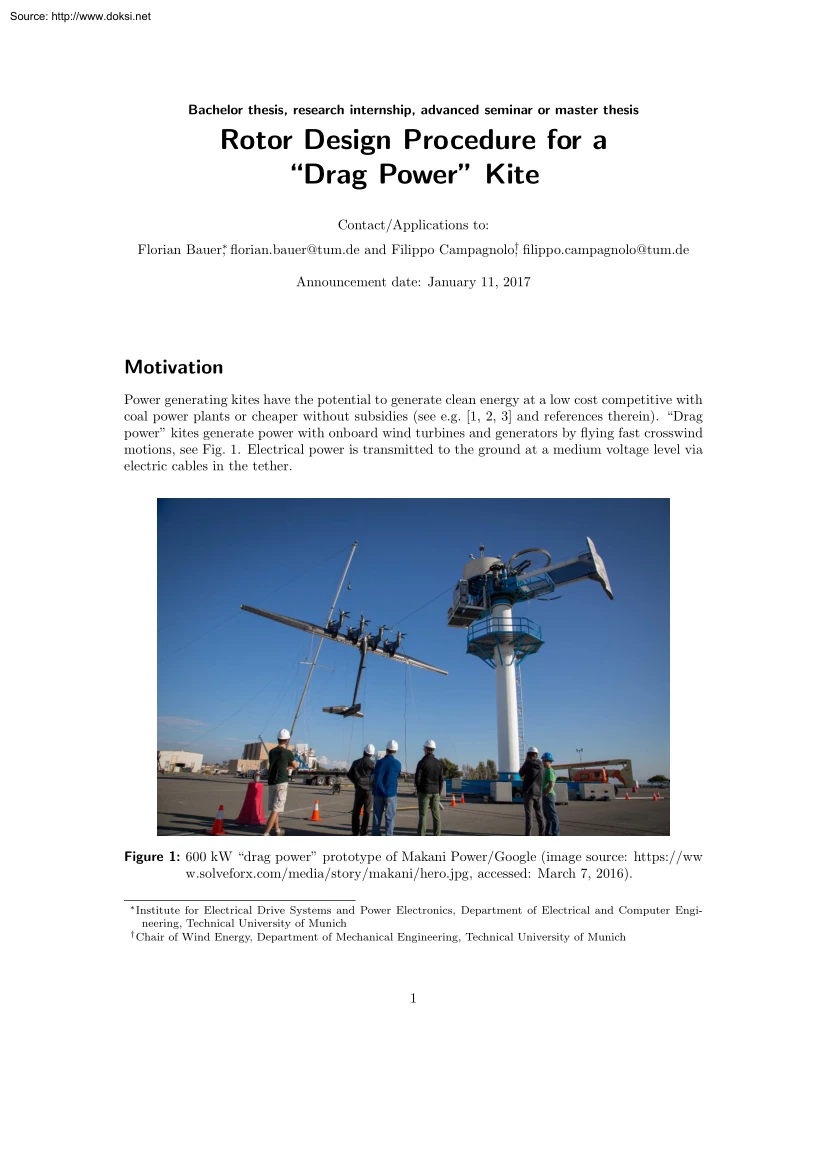A doksi online olvasásához kérlek jelentkezz be!

A doksi online olvasásához kérlek jelentkezz be!
Nincs még értékelés. Legyél Te az első!
Mit olvastak a többiek, ha ezzel végeztek?
Tartalmi kivonat
Source: http://www.doksinet Bachelor thesis, research internship, advanced seminar or master thesis Rotor Design Procedure for a “Drag Power” Kite Contact/Applications to: ∗ Florian Bauer, florian.bauer@tumde and Filippo Campagnolo†, filippocampagnolo@tumde Announcement date: January 11, 2017 Motivation Power generating kites have the potential to generate clean energy at a low cost competitive with coal power plants or cheaper without subsidies (see e.g [1, 2, 3] and references therein) “Drag power” kites generate power with onboard wind turbines and generators by flying fast crosswind motions, see Fig. 1 Electrical power is transmitted to the ground at a medium voltage level via electric cables in the tether. Figure 1: 600 kW “drag power” prototype of Makani Power/Google (image source: https://ww w.solveforxcom/media/story/makani/herojpg, accessed: March 7, 2016) ∗ Institute for Electrical Drive Systems and Power Electronics, Department of Electrical and
Computer Engi- neering, Technical University of Munich † Chair of Wind Energy, Department of Mechanical Engineering, Technical University of Munich 1 Source: http://www.doksinet Tasks, Suggested Solution Approach, Expected Results In this student work, a rotor design procedure for a “drag power” kite shall be developed with a Blade Element Momentum model and implemented as a MATLAB script. The design may start with certain user inputs such as rotor diameter and number of blades. The design procedure then computes the optimal airfoil, chord distribution and twist distribution. Hereby, a constraint for the optimization is the required thrust for hovering to lift the kite for start and landing maneuvers. Another constraint is that the blades are able to withstand the aerodynamic loads. An example rotor design shall also be verified with CFD and FEM simulations. One result is the documented design procedure itself and the MATLAB script to execute the procedure. Another result is
a CAD-file of the lofted rotor and the documented CFD- and FEM-verification files. Starting Point This announcement, the literature list below and additionally provided simulation files and internal documents upon start. Report and Presentation Guidelines One report (or thesis) and at least one presentation of the results are required. Guidelines and templates can be downloaded from https://github.com/floba/StudentGuidelines Your Profile This student work will be jointly supervised by the Institute for Electrical Drive Systems and Power Electronics and the Chair of Wind Energy. The ideal candidate • is a student in mechanical engineering, electrical engineering, math, informatics or related fields, • has experience/knowledge in FEM and CFD simulations, • has good skills in MATLAB, Office, LaTeX, • is motivated in the respective field of science and engineering, • has good English and German language skills. References [1] M. Loyd, “Crosswind kite power,” Journal of
Energy, vol 4, no 3, pp 106–111, 1980 [2] U. Ahrens, M Diehl, and R Schmehl, Eds, Airborne Wind Energy, ser Green Energy and Technology. Springer Berlin Heidelberg, 2013 [3] Makani Power/Google: Website, https://www.googlecom/makani/, accessed: Nov 30, 2016 [4] T. Burton, N Jenkins, D Sharpe, E Bossanyi, Wind Energy Handbook, Wiley, 2011 [5] J. F Manwell, JG McGowan, AL Rogers, Wind Energy Explained, Theory, Design and Application, Wiley, 2012. 2
Computer Engi- neering, Technical University of Munich † Chair of Wind Energy, Department of Mechanical Engineering, Technical University of Munich 1 Source: http://www.doksinet Tasks, Suggested Solution Approach, Expected Results In this student work, a rotor design procedure for a “drag power” kite shall be developed with a Blade Element Momentum model and implemented as a MATLAB script. The design may start with certain user inputs such as rotor diameter and number of blades. The design procedure then computes the optimal airfoil, chord distribution and twist distribution. Hereby, a constraint for the optimization is the required thrust for hovering to lift the kite for start and landing maneuvers. Another constraint is that the blades are able to withstand the aerodynamic loads. An example rotor design shall also be verified with CFD and FEM simulations. One result is the documented design procedure itself and the MATLAB script to execute the procedure. Another result is
a CAD-file of the lofted rotor and the documented CFD- and FEM-verification files. Starting Point This announcement, the literature list below and additionally provided simulation files and internal documents upon start. Report and Presentation Guidelines One report (or thesis) and at least one presentation of the results are required. Guidelines and templates can be downloaded from https://github.com/floba/StudentGuidelines Your Profile This student work will be jointly supervised by the Institute for Electrical Drive Systems and Power Electronics and the Chair of Wind Energy. The ideal candidate • is a student in mechanical engineering, electrical engineering, math, informatics or related fields, • has experience/knowledge in FEM and CFD simulations, • has good skills in MATLAB, Office, LaTeX, • is motivated in the respective field of science and engineering, • has good English and German language skills. References [1] M. Loyd, “Crosswind kite power,” Journal of
Energy, vol 4, no 3, pp 106–111, 1980 [2] U. Ahrens, M Diehl, and R Schmehl, Eds, Airborne Wind Energy, ser Green Energy and Technology. Springer Berlin Heidelberg, 2013 [3] Makani Power/Google: Website, https://www.googlecom/makani/, accessed: Nov 30, 2016 [4] T. Burton, N Jenkins, D Sharpe, E Bossanyi, Wind Energy Handbook, Wiley, 2011 [5] J. F Manwell, JG McGowan, AL Rogers, Wind Energy Explained, Theory, Design and Application, Wiley, 2012. 2




